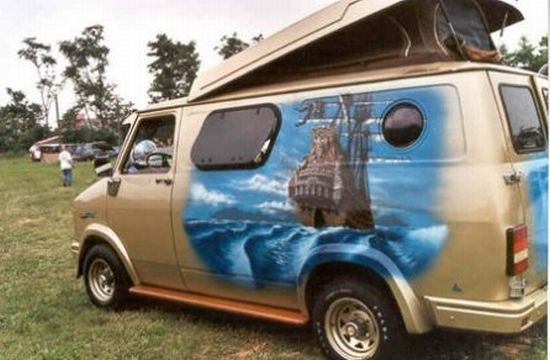|
|
Artistic Van
|
In the United States, a van can also refer to a box-shaped trailer or semi-trailer used to carry goods. In this case there is a differentiation between a "dry van", used to carry most goods, and a refrigerated van, or reefer, used for cold goods. A railway car used to carry baggage is also called a van. A vehicle referred to as a full size van is usually a large, boxy vehicle that has a platform and powertrain similar to their light truck counterparts. These vans may be sold with the space behind the front seats empty for transporting of goods (cargo van), or furnished for passenger use by either the manufacturer (Wagon) or another company for more personal comforts, such as entertainment systems (Conversion van). Full size vans often have a very short hood, with the engine block moved to within the passenger cabin. A cutaway van chassis is a variation of the full size van which was developed for use by many second stage manufacturers. Such a unit generally has a van front end, and driver controls in a cab body which extends only to a point aft of the driver and passenger seats, where the rest of the van body is cutoff (leading to the terminology "cutaway"). From that point aft, usually only the chassis frame rails and running gear extend to the rear when the unit is shipped as an "incomplete vehicle". A second stage manufacturer, commonly known as a bodybuilder, will complete the vehicle for uses such as recreational vehicles, small school buses, minibuses, type III ambulances, and delivery trucks. A large portion of cutaway van chassis are equipped with dual rear wheels. Some second stage manufacturers also add a third weight-bearing single wheel "tag axle" for larger minibus models. The term van may also refer to a Minivan. However, minivans are usually distinguished by their smaller size and traditionally front wheel drive powertrain, although many now are being equipped with four wheel drive. Minivans offer similar seating capacity (traditionally seven to eight passengers), and better fuel economy than full-size vans, at the expense of power, cargo space, and towing capacity. In addition, many new minivans have dual side sliding doors.
In urban areas of the United States full-size vans have been used as commuter vans since 1971, when Dodge introduced a van that could transport up to 15 passengers. Commuter vans are used as an alternative to carpooling and other ride sharing arrangements. Many mobile businesses use a van to carry almost their entire business to various places where they work. For instance, there are those who come to homes or places of business to perform services or to install or repair appliances. Vans are also used to shuttle people and their luggage between hotels and airports, to transport commuters between parking lots and their places of work, and along established routes as minibuses. Vans are also used to transport elderly and mobility-impaired worshipers to and from church services or to transport youth groups for outings to amusement parks, picnics, and visiting other churches. Vans are also used by schools to drive sports teams to intermural games.
|
|









